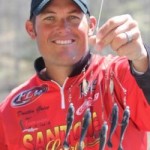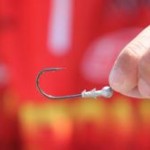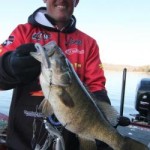Tips on Setting up Castable Umbrella Rigs
By Brad Wiegmann
from The Fishing Wire
Fishing is complicated. There are thousands of lures and hundreds of jig heads to rig them on. It’s frustrating.
Pro Angler Dustin Grice likes A-Rigs for targeting suspended fish, as well as those around structure.Selecting the best lure and jig head for the right technique can be overwhelming, in addition to figuring out the right weight of the jig head along with hook size and style.
Jig heads don’t look complicated, but they are all different and made for specific techniques. Those designed for swimbaits are commonly used on castable, multi-lure rigs or combined with a soft plastic lure. FLW Tour angler Dustin Grice has put a lot of thought into what works best where and when.
“Prime time to fish with the Alabama Rig, A-rig or castable umbrella rig is during the prespawn. Once the water temperature gets 50 degrees in the early spring it’s hard not to cast because of how many big fish it catches. The next best time is later on in October when the water temperatures begin to fall, however, you can still catch bass on it during the summertime offshore fishing ledges,” said Grice.
When selecting lures to rig on his castable umbrella rigs, Grice matches the bait size. During the spring, he uses small-bodied swimbaits and changes to a larger profile as the bait grows during the year. Once Grice finds the right size, he will rig all of the jig heads with it.
The double barb on this type of jig helps to keep the soft plastic tail in place during repeated casting.“Really, jig heads may be more important than lure size when it comes to catching fish on castable multi-lure rigs. The weight of the jig heads determine how deep the lure will run. Hook size will determine what size lure to use. A castable umbrella rig has to be down in the strike zone to get a bite,” said Grice.
Right speed and presentation can also make a difference with the number of fish you catch when fishing a castable multi-lure rig. “It’s great for catching suspending bass. I just count it down to where the bass are and then start a slow retrieve. Sometimes, I will pause it when its coming back in and that will trigger a strike,” said Grice.
“I think bass like to bust up a school of baitfish then come back and eat them. I call that a “swim through.” It’s great because you know that any second after that happens you’re going to get a bite,” said Grice.
Grice acknowledged a large percentage of the time he uses 1/8-ounce Th’ Rig Head by Santone Lures on all five of the wire arms. Other times he will put 1/16-ounce jig heads on the top two wire arm and three 1/8-ounce heads on the remaining wire arms. He believes this keeps the castable multi-lure rig running true.
“95 percent of all the hits on a multi-lure rig are on the bottom three jig heads,” said Grice.
For Grice the gap between the hook point and hook eyelet is the key to catching fish when using a castable multi-lure rig. He also wants a jig head that lets the water move around it better creating a lifelike swimming action.
Another FLW Tour pro, Jim Tutt, also fishes castable multi-lure rigs. “It’s a lure just like any other lure, but when that bite is on you had better be throwing it as long as it’s legal in the tournament and state you are fishing in,” said Tutt. The Kellogg’s Rice Krispies pro is no stranger to the castable multi-lure rig having caught his biggest bass on it weighing over 11 pounds.
A large percentage of the time, Tutt will rig 1/8-ounce jigs with 4/0 hooks on all the wire arms. “I really don’t think hook size matters when a bass is going after a castable multi-lure rig. A bass is just trying to bust up the school,” said Tutt.
His favorite presentation is just casting out and letting the castable multi-lure rig fall to the bottom then slow rolling it back in. If the bass are suspended, Tutt will count down to where the fish are suspended then start reeling in slowly.
What’s important to Tutt when fishing a castable multi-lure rig is his jig heads.
“I use the Santone Lures Th’ Rig Head. These jig heads feature a drop weight system that keeps the jig heads from wrapping up or tangling, round ball head giving the lure great side to side motion and a double-barbed model or over-sided screw lock model for keeping the lure in place,” said Tutt.
Tutt added on solid bodied swimbaits the double-barbed model lures will stay on even without using super glue. On hollow bodied swimbaits, Tutt will put a drop of super glue to keep it in place.
Both smallmouths like this one and largemouths are susceptible to the swimming “school” of bait represented by A-Rigs.“I use these heads because they have heavy duty hooks and when you are fishing with a castable multi-lure rig it’s not little fish you’re catching on it,” said Tutt.
Th’ Rig Head double-barbed model is available in 1/16-ounce with 3/0 Mustad hook, 1/8-ounce with 4/0 Mustad hook, or 1/8-ounce with 5/0 Mustad hook and over-sized screw lock model in 1/8-ounce with 4/0 or 1/4-ounce with a 5/0 Mustad hook.
As for gear, Grice uses a 7 foot, 6 inch flipping stick with 65 pound braid on a 6.3:1 reel. Tutt uses 65 pound braid, 7 foot, 2 inch heavy action rod with a 6.3:1 Shimano Calais reel.
In addition to using these heads on castable multi-lure rigs, Grice uses swimbaits rigged with them almost year round. His favorite targets with this combination are rocky areas and points.
“On reservoirs like Beaver Lake and Table Rock, I will put on a 1/8-ounce head rigged with a swimming fluke Jr. and fish it everywhere there’s rock. I will tie on 6- to 8-pound test and fish it on a spinning rod. The spotted bass and smallmouth just love it when it’s reeled back in slowly,” said Grice.
He changes to baitcasting equipment and heavier 15 pound test fluorocarbon fishing line when fishing Lake Sam Rayburn, Kentucky Lake, or Toledo Bend. Grice will also switch to a full sized swimbait. Again, Grice likes to reel it back in slowly after it falls to the bottom.


